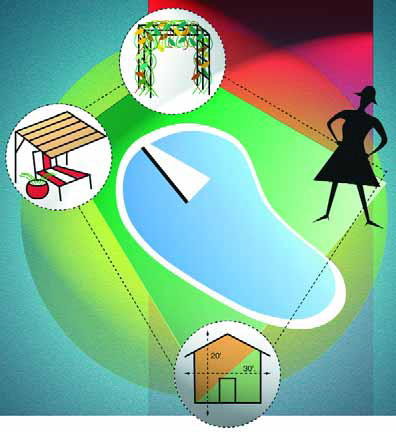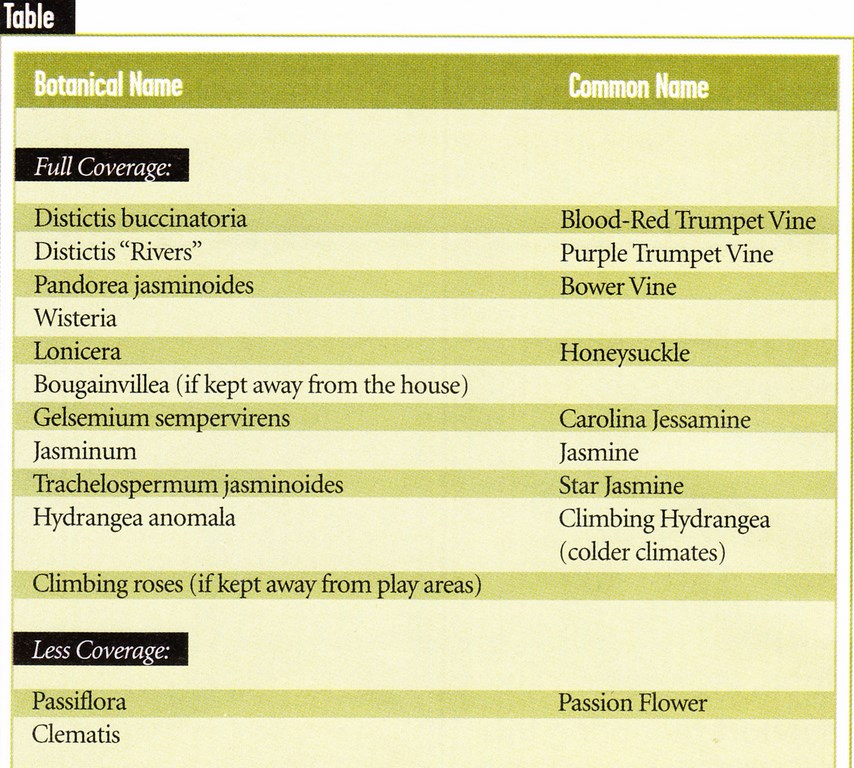Safe Arbor

Contrary to the impression that might be given by the headline, this isn’t an article about building arbors that are safe. Rather, it’s about how you can protect your clients and their guests from the sun by building beautiful structures in their yards. (Safety is part of the discussion, too, but not its focus.)
I bring this up because many clients put piles of money into building spectacular pools but fail to give much thought to their surroundings. That’s a shame, because those surroundings almost certainly will be seen much more than the pools will be used in the course of the average year.
Several things need to be considered here along with a pool: Have you, for example, set up a convenient place for your clients to sit in the shade and watch the kids playing in the water? Will they be able to converse with guests who are lounging in the pool at times when they don’t feel like getting in themselves? Is there a way for them to relax or meditate near the watershape without being blasted by the heat and sun?
By considering these issues early and making your clients aware that you have thought about more than building just a watershape, you’ll help build their confidence in you and incline them to increase the budget to address the issues you raise.
CHOICES AND QUESTIONS
As we all become more aware of the dangers of UV exposure and the need to protect ourselves, arbors and other garden structures are becoming more and more important and popular as a means of sheltering skin from potential damage.
You might plant a shade tree near the watershape, but your client’s yard may not lend itself to this type of landscaping – or they just might want a solid structure instead of a plant for this purpose. The possibilities literally are endless when it comes to approaching these sun-exposure issues.
You could build a structure that has a solid roof and provides total coverage, for instance, or a decorative arbor that’s meant to stand alone, or an arbor with open slats that will support vines. To guide your clients in these decisions, you need to consider a number of factors:
* What is the style of the garden? There are many options here, and arbors fit right into most of them from the wildest to the most formal.
* What is the proximity of the structure to the watershape? If the arbor is intended as a shaded place from which to watch the kids in the pool, placing a garden structure clear across the yard will make it inconvenient – and a waste of your clients’ money.
* What is the style of the house? Building a bamboo structure next to a colonial house would probably be a little too eclectic for most tastes. It would be better to carry the existing style of the house into the arbor and find specific design elements on the house that can be “borrowed” for the garden structure.
* How much space is available to house such a structure? If all you have is a 10-by-10-foot seating area, the arbor might only shelter a couple of chairs and a side table or maybe just a single lounge chair. With unlimited space, obviously, your options might be limitless as well.
After addressing these issues, you need to make a list of your clients’ needs. I start by asking another series of questions:
[ ] What is the purpose of the arbor? Is it strictly for shade, or will it house a barbecue or other entertainment area? Will it also be used for storage or some other purpose?
[ ] How will a garden structure affect the flow of traffic in the yard? Will the proposed location truly be functional and fit your clients’ lifestyle?
[ ] What’s the best location for a structure in the yard? Will they be carrying food out from the kitchen to be served under the structure and will they consequently want it close to the house? Will it be better placed away from the house for quiet and solitude?
[ ] What type of structure do they want, open or fully covered?
[ ] What furnishings (chairs, tables, barbecues, planters) are they thinking about placing under the structure?
[ ] Do they want to grow something on the structure?
Armed with the answers to these questions, you’re almost ready to design and build – once, that is, you accommodate one more issue: Do they have children? If the answer is yes, you most likely will want to put a garden structure as near to the pool as possible – but far enough away to avoid the “splash factor.”
If the answer is yes, it’s also likely you’ll have to consider something you may not have considered otherwise, and that is how the structure may potentially break up the visual and physical flow of the yard. (This is particularly true of smaller yards.) The key here is to place any structure out of the way of kids’ play areas – but not so far away that parents can’t supervise play.
UNDER CONSTRUCTION
As a practical matter, most homeowners capable of digging holes and swinging hammers think they can build these structures without the help of a licensed contractor. It’s your job to convince them otherwise.
The easiest way to do this is to remind them that there may be local building codes requiring certain features on any garden structure. (The rules may vary widely depending on where you live, so it pays to check in with local building departments.)
If that doesn’t work and the structure is of a size or design that makes construction skill an issue, it’s time to talk about things like structural integrity or earthquake-resistant foundations and any other factor you see as taking the project out of the realm of the do-it-yourselfer and placing it in a professional’s hands.
But be realistic: Make them aware of these issues and your concerns before you offer a bid or put too much effort into creating blueprints. I have had many clients take me all the way through the design and blueprint process only to discover that the project is just too expensive.
By the same token, that doesn’t mean that you should shy away from budget discussions or shouldn’t give them ballpark figures to chew on. I start talking about money as early in the process as possible, explaining everything so they understand what’s involved and why things cost what they do.
In doing so, I cover everything from the simplest option to the most complicated. I tell them, for example, that the arbor or other structure they see at a garden center may be the least-expensive alternative, while the most expensive might be a large, steel-reinforced structure with a wood façade. This gives them points of reference and will help them, if you’ve been convincing, decide that the redwood arbor they can get for a song is probably not the right long-term choice.
Experience tells me that most people have no idea what landscaping costs, so as a result they allocate the least amount of their construction budget to plants and garden structures. That said, the easiest way to dissuade them from building something themselves or cutting quality corners is to explain to them the potential for a garden structure to be a battering ram during an earthquake or a missile in high winds if it’s not properly constructed!
WHAT TO PLANT?
I don’t have the room here to cover all the possibilities for garden structures you could build – and I don’t think I could do so even in a year’s worth of columns. One thing I can say is that the answers to the questions posed above will lead you in a specific, individual direction for each of your clients – and the possibilities really are endless.
 To show what I mean about the broad range of options you have, let’s take a look at just one arbor option – something you intend to cover with a vine of some sort. (This happens to be my personal favorite.)
To show what I mean about the broad range of options you have, let’s take a look at just one arbor option – something you intend to cover with a vine of some sort. (This happens to be my personal favorite.)
You can plant and grow vines on just about any type of structure, but you will reap the greatest aesthetic benefits of growing vines on those with open tops. So what sort of vine should you pick?
Bougainvillea is a common choice: It will cover a rooftop and mound up with lots of flowers. But I’d consider other options as well, because Bougainvillea brings up a long-term safety issue and can become a fire hazard if it gets too woody and becomes too mounded. It’s like stacking a pile of kindling on the roof!
What else? Well, since we’re talking about building something to protect people from the sun, you can be fairly well assured that whatever you build, you can plant something on the posts of the structure that will grow up and cover it because it will have great sun exposure.
The table shown above lists some great vines to plant on garden structures. I picked these because I’ve had the greatest success with them through the years, but there’s much more to explore. If none are of interest to your clients, check with your local nursery or garden guide or e-mail me for suggestions.
Stephanie Rose wrote her Natural Companions column for WaterShapes for eight years and also served as editor of LandShapes magazine. She may be reached at sroseld@gmail.com.










